- Calendar
- Online Ticket Sales
- Access
- JA
- EN
Celebrating a Decade in Roppongi
The First Showing of the Box with Fusenryo Design in Mother-of-Pearl Inlay and Maki-e (a National Treasure) after Its Restoration
A Sacred Treasure Box
May 31 to July 17, 2017
※There will be an exhibition change during the course of exhibition
*Download the list of changes in works on display
The list of changes in worksPDF
Part 1: Jeweled Boxes
The more important the objects to be stored inside them, the more beautifully boxes tend to be decorated. Indeed, when we think of “treasure boxes,” these are almost always lavish items in and of themselves. This desire to create beautiful boxes in which to store our jewelry, precious cosmetic implements, cherished keepsakes, and other prized items remains unchanged today from the way of the past.
Most symbolic of this desire for beauty are the accessory boxes that were used in the Heian period for storing important and valuable personal effects. These boxes are believed to have been modeled after Chinese boxes for storing combs and mirrors and therefore maintained a prominent association with cosmetics. As such, they were a prime component of women’s personal effects and sumptuous designs were particularly appropriate to their role as “formal furnishings.” At the same time, they were also a central item in shrine offerings and these dazzlingly adorned boxes that constituted the ultimate in extravagance and luxury were also known as “furnishings of the gods.”
Also, although these boxes originally served an auxiliary role as containers to hold the items that were to be placed inside them, time after time value came to be placed upon the beauty of the boxes themselves, and eventually they became objects that were collected and cherished on their own. This section will introduce a selection of precious accessory boxes that have mesmerized people for ages.
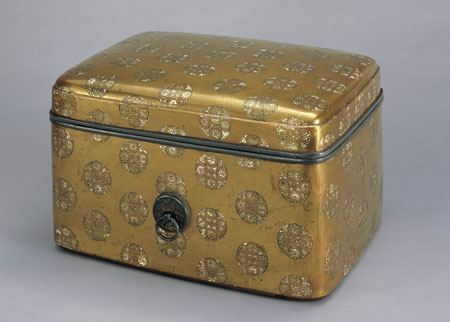
Kamakura period, 13th century
Suntory Museum of Art
【To be shown over an entire period】
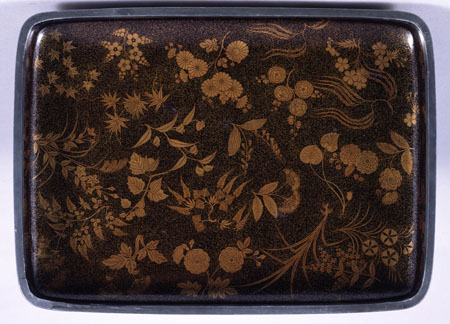
Kamakura period, 13th century
Suntory Museum of Art
【To be shown over an entire period】
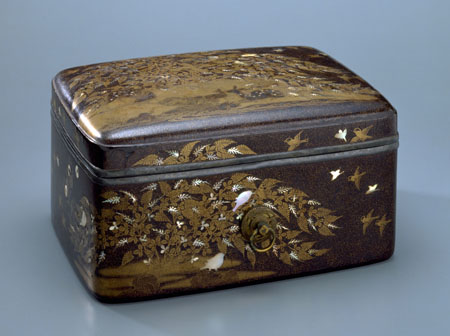
Kamakura period, 13th century
Izumo Ōyashiro, Shimane
【To be shown between May 31 and Jun.26】
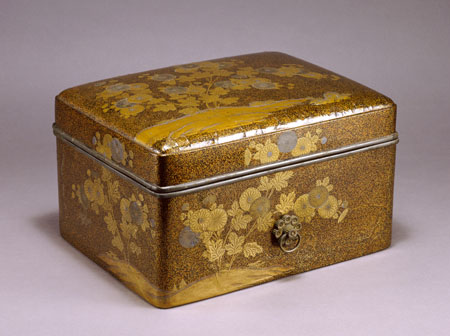
Nanbokuchō to Muromachi period, 14th century
Kyushu National Museum
(Picture provided by Kyushu National Museum, Photo by Takeshi Fujimori)
【To be shown between May 31 and Jun.26】
Part 2: The Mystical Power of Accessory Boxes
The term “jeweled box” suggests not only beautiful boxes, but also calls to mind implications of secrecy and containers that are not meant to be opened. Even today, the act of opening an unfamiliar box with a closed lid can elicit feelings of anxiety, if not excitement. Perhaps for this reason, there have been numerous strange tales about boxes since ancient times, starting with the legend of Urashima Tarō.
Also, the idea of these accessory boxes as cosmetic boxes brings up connections not only with makeup, which suggests “transformation” or the legend of the “black hair-securing vine” in the Kojiki (Records of Ancient Matters), but also implicates hair combs, which in ancient times were associated with supernatural powers. Thus, it is not difficult to imagine that the boxes in which these various accessories were placed were also believed to possess a kind of magical power. They were certainly also related to some extent to the practice of placing combs and other accessories in ancient burial tombs and inside of Buddhist sculptures as dedicatory offerings.
This section presents the Accessory Box and Contents with Pine and Plum Design in Maki-e Sprinkled Gold, which has been passed down as a “jeweled box” in the region that is known for the legend of Yamasachi-hiko and Umisachi-hiko. It also features other objects related to miraculous legends of boxes as well as cherished cosmetic implements from the Heian period that were dedicated inside Buddhist statues.
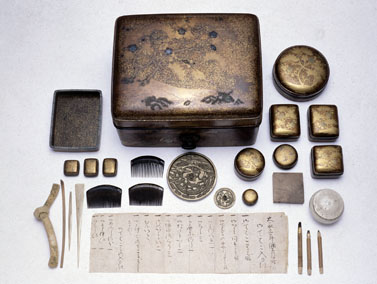
Muromachi period, 16th century
Hirakiki Jinja, Kagoshima
【To be shown between May 31 and Jun.26】
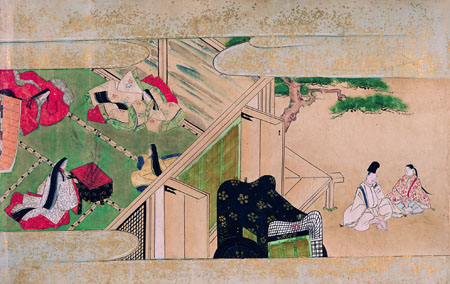
One of two handscrolls
Edo period, 17th century
Suntory Museum of Art
【To be shown over an entire period】
Part 3: Accessory Boxes in Daily Life
Beyond holding cosmetic supplies, the accessory box, which came into being in the Heian period, constituted an intimate part of daily life as a container for various personal belongings, such as fans, books, and other items.
These accessory boxes were not always magnificently decorated “jeweled boxes,” but were in many cases produced in simple techniques appropriate for everyday use, as can be seen in various artifacts from archaeological sites.
The Ruijū zatsuyōshō, a record of furnishings and interior display, provides descriptions of basic daily necessities from the second half of the Heian period and the Ruijū zatsuyōshō sashizukan sets forth its teachings in the form of an illustrated instruction manual. Using the accessory boxes depicted in this manual as a reference, this section presents a selection of mirror cases, various types of incense containers, and other objects that originally would have filled such boxes, and presents them as they were used in daily life at that time. Other cosmetic accessories and furnishings are also displayed together with illustrated documentation of their respective uses, providing insights into some aspects of court life that gave rise to the use of these boxes.
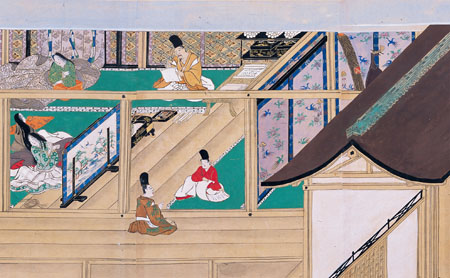
Tani Bunchō, One of seven handscrolls
Edo period, 19th century
Suntory Museum of Art
【To be shown between May 31 and Jun.19】
Part 4: The Fusenryō Design and Courtly Motifs
The fusenryō design that appears on the Accessory Box with Fusenryō Design in Mother-of-Pearl Inlay and Maki-e Sprinkled Gold was one of the so-called yūsoku designs, which appeared on aristocratic clothing and furnishings in accordance with family rank and status from the Heian period onward. In addition to serving as the foundation for Japanese design, these were also extremely important symbols that held social meaning within the special protocols of court etiquette.
The term fusenryō was originally the name of a technique for producing a type of brocade with raised designs, but later came to be used to refer to a particular kind of floral roundel. From about the late Heian period onward, it became the name of this pattern even when it was not rendered in the raised technique. There were various other variations on this theme, including a fusechō pattern, which consisted of Chinese flowers in the form of butterflies, and another design of Chinese flowers resembling chrysanthemums, as well as similar examples of wisteria roundels.
This section presents several examples of court patterns, primarily centered around fusenryō, and also including the paulownia, bamboo, phoenix, and qilin motif, triple cord diamonds, and small hollyhock patterns. These are exhibited in conjunction with screens and other pictorial documentation of their uses, as well as clothing and costume, mirrors, and other decorative art objects displaying these patterns.
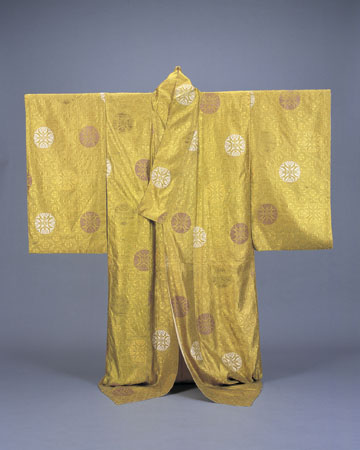
Small hollyhock and fusenryō roundel design on yellow-green ground
(from the sacred treasures of Kumano Hayatama Taisha)
ca. 1390 (Meitoku 1)
Kumano Hayatama Taisha, Wakayama
【To be shown between May 31 and Jun.26】
Section 5: Sacred Treasures and Court Craft
Japan’s gods, which originally had no distinct recognizable shape, became influenced by Buddhist statuary and at length took on human form. Subsequently, people began to make offerings of clothing, accessories, and furnishings, so that the gods could live in comfort within the shrine precincts. These various art objects are referred to as “sacred treasures” (shinpō). In form, they took after items found at the court, since the lifestyles of the gods were modeled on the daily lives of the members of the aristocracy who were making the offerings to them. The fact that the accessory box became a representative sacred treasure offering also confirms its importance as a feature of court life.
The accessory boxes that have been passed down as ancient sacred treasures of Kumano Hayatama Taisha in Wakayama prefecture come from an offering of clothing and furnishings that was prepared and dedicated in 1390 (Meitoku 1) under the directive of the Muromachi shogunate. Each of the thirteen boxes in the offering was luxuriously decorated, including its inner contents. The accessory boxes that are believed to have been dedicated to the particularly high-ranking deities of Musubi no miya, Hayatama no miya, and Shōjōden, display the same sumptuous maki-e technique of ikakeji densely sprinkled gold powder as was used on the fusenryō box and they are decorated in motifs that are befitting of the title “furnishings of the gods.” This section displays accessory boxes along with clothing and furnishings from the sacred treasures that have been passed down in the collections of famous shrines and convey the form of court craft. It presents a dazzling array of objects that were specially designed for this sacred purpose.
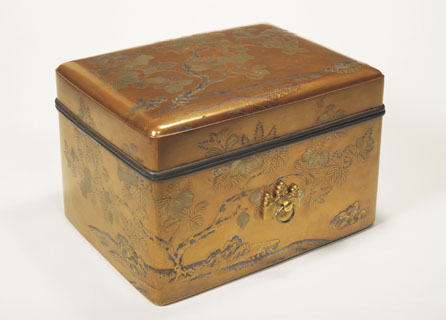
(from the sacred treasures of Kumano Hayatama Taisha)
ca. 1390 (Meitoku 1)
Kumano Hayatama Taisha, Wakayama
(Picture provided by Nara National Museum, Photo by Kinji Morimura)
【To be shown between May 31 and Jun.26】
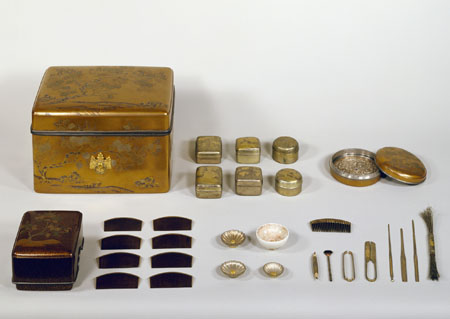
(from the sacred treasures of Kumano Hayatama Taisha)
ca. 1390 (Meitoku 1)
Kumano Hayatama Taisha, Wakayama
(Picture provided by Nara National Museum, Photo by Kinji Morimura)
【To be shown between May 31 and Jun.26】
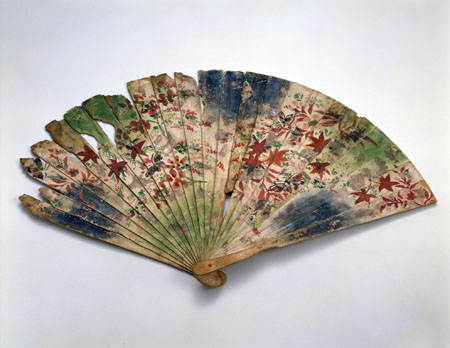
Heian period, 12th century
Sada Jinja, Shimane (Picture provided by Shimane Museum of Ancient Izumo)
【To be shown between Jun.21 and Jul.17】
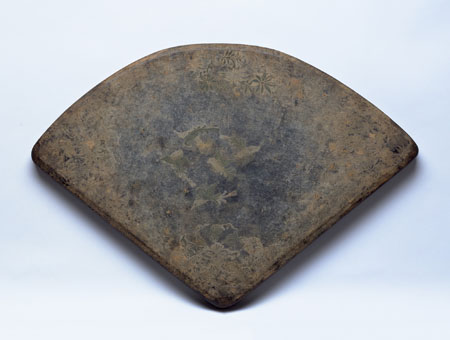
(Important Cultural Property)
Heian period, 12th century
Sada Jinja, Shimane (Picture provided by Shimane Museum of Ancient Izumo)
【To be shown between Jun.21 and Jul.17】
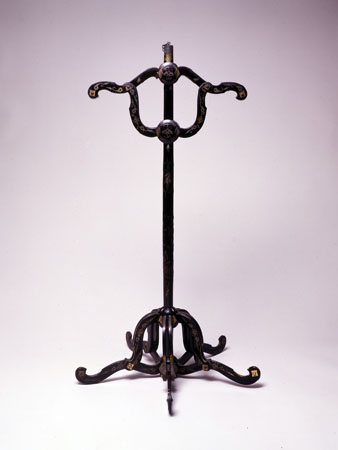
(from the sacred treasures of Atsuta Jingū)
Muromachi period, 15th century
Atsuta Jingū, Aichi
【To be shown over an entire period】
*Unauthorized reproduction or use of texts or images from this site is prohibited.
2025 January
- Exhibition
- Closed
- Tea Ceremony
- Mon
- Tue
- Wed
- Thu
- Fri
- Sat
- Sun
- 1
- 2
- 3
- 4
- 5
- 6
- 7
- 8
- 9
- 10
- 11
- 12
- 13
- 14
- 15
- 16
- 17
- 18
- 19
- 20
- 21
- 22
- 23
- 24
- 25
- 26
- 27
- 28
- 29
- 30
- 31
2025 February
- Exhibition
- Closed
- Tea Ceremony
- Mon
- Tue
- Wed
- Thu
- Fri
- Sat
- Sun
- 1
- 2
- 3
- 4
- 5
- 6
- 7
- 8
- 9
- 10
- 11
- 12
- 13
- 14
- 15
- 16
- 17
- 18
- 19
- 20
- 21
- 22
- 23
- 24
- 25
- 26
- 27
- 28
2025 March
- Exhibition
- Closed
- Tea Ceremony
- Mon
- Tue
- Wed
- Thu
- Fri
- Sat
- Sun
- 1
- 2
- 3
- 4
- 5
- 6
- 7
- 8
- 9
- 10
- 11
- 12
- 13
- 14
- 15
- 16
- 17
- 18
- 19
- 20
- 21
- 22
- 23
- 24
- 25
- 26
- 27
- 28
- 29
- 30
- 31
2025 April
- Exhibition
- Closed
- Tea Ceremony
- Mon
- Tue
- Wed
- Thu
- Fri
- Sat
- Sun
- 1
- 2
- 3
- 4
- 5
- 6
- 7
- 8
- 9
- 10
- 11
- 12
- 13
- 14
- 15
- 16
- 17
- 18
- 19
- 20
- 21
- 22
- 23
- 24
- 25
- 26
- 27
- 28
- 29
- 30
2025 May
- Exhibition
- Closed
- Tea Ceremony
- Mon
- Tue
- Wed
- Thu
- Fri
- Sat
- Sun
- 1
- 2
- 3
- 4
- 5
- 6
- 7
- 8
- 9
- 10
- 11
- 12
- 13
- 14
- 15
- 16
- 17
- 18
- 19
- 20
- 21
- 22
- 23
- 24
- 25
- 26
- 27
- 28
- 29
- 30
- 31
2025 June
- Exhibition
- Closed
- Tea Ceremony
- Mon
- Tue
- Wed
- Thu
- Fri
- Sat
- Sun
- 1
- 2
- 3
- 4
- 5
- 6
- 7
- 8
- 9
- 10
- 11
- 12
- 13
- 14
- 15
- 16
- 17
- 18
- 19
- 20
- 21
- 22
- 23
- 24
- 25
- 26
- 27
- 28
- 29
- 30
2025 July
- Exhibition
- Closed
- Tea Ceremony
- Mon
- Tue
- Wed
- Thu
- Fri
- Sat
- Sun
- 1
- 2
- 3
- 4
- 5
- 6
- 7
- 8
- 9
- 10
- 11
- 12
- 13
- 14
- 15
- 16
- 17
- 18
- 19
- 20
- 21
- 22
- 23
- 24
- 25
- 26
- 27
- 28
- 29
- 30
- 31
2025 August
- Exhibition
- Closed
- Tea Ceremony
- Mon
- Tue
- Wed
- Thu
- Fri
- Sat
- Sun
- 1
- 2
- 3
- 4
- 5
- 6
- 7
- 8
- 9
- 10
- 11
- 12
- 13
- 14
- 15
- 16
- 17
- 18
- 19
- 20
- 21
- 22
- 23
- 24
- 25
- 26
- 27
- 28
- 29
- 30
- 31
2025 September
- Exhibition
- Closed
- Tea Ceremony
- Mon
- Tue
- Wed
- Thu
- Fri
- Sat
- Sun
- 1
- 2
- 3
- 4
- 5
- 6
- 7
- 8
- 9
- 10
- 11
- 12
- 13
- 14
- 15
- 16
- 17
- 18
- 19
- 20
- 21
- 22
- 23
- 24
- 25
- 26
- 27
- 28
- 29
- 30
2025 October
- Exhibition
- Closed
- Tea Ceremony
- Mon
- Tue
- Wed
- Thu
- Fri
- Sat
- Sun
- 1
- 2
- 3
- 4
- 5
- 6
- 7
- 8
- 9
- 10
- 11
- 12
- 13
- 14
- 15
- 16
- 17
- 18
- 19
- 20
- 21
- 22
- 23
- 24
- 25
- 26
- 27
- 28
- 29
- 30
- 31
2025 November
- Exhibition
- Closed
- Tea Ceremony
- Mon
- Tue
- Wed
- Thu
- Fri
- Sat
- Sun
- 1
- 2
- 3
- 4
- 5
- 6
- 7
- 8
- 9
- 10
- 11
- 12
- 13
- 14
- 15
- 16
- 17
- 18
- 19
- 20
- 21
- 22
- 23
- 24
- 25
- 26
- 27
- 28
- 29
- 30
2025 December
- Exhibition
- Closed
- Tea Ceremony
- Mon
- Tue
- Wed
- Thu
- Fri
- Sat
- Sun
- 1
- 2
- 3
- 4
- 5
- 6
- 7
- 8
- 9
- 10
- 11
- 12
- 13
- 14
- 15
- 16
- 17
- 18
- 19
- 20
- 21
- 22
- 23
- 24
- 25
- 26
- 27
- 28
- 29
- 30
- 31
2026 January
- Exhibition
- Closed
- Tea Ceremony
- Mon
- Tue
- Wed
- Thu
- Fri
- Sat
- Sun
- 1
- 2
- 3
- 4
- 5
- 6
- 7
- 8
- 9
- 10
- 11
- 12
- 13
- 14
- 15
- 16
- 17
- 18
- 19
- 20
- 21
- 22
- 23
- 24
- 25
- 26
- 27
- 28
- 29
- 30
- 31
2026 February
- Exhibition
- Closed
- Mon
- Tue
- Wed
- Thu
- Fri
- Sat
- Sun
- 1
- 2
- 3
- 4
- 5
- 6
- 7
- 8
- 9
- 10
- 11
- 12
- 13
- 14
- 15
- 16
- 17
- 18
- 19
- 20
- 21
- 22
- 23
- 24
- 25
- 26
- 27
- 28
2026 March
- Exhibition
- Closed
- Mon
- Tue
- Wed
- Thu
- Fri
- Sat
- Sun
- 1
- 2
- 3
- 4
- 5
- 6
- 7
- 8
- 9
- 10
- 11
- 12
- 13
- 14
- 15
- 16
- 17
- 18
- 19
- 20
- 21
- 22
- 23
- 24
- 25
- 26
- 27
- 28
- 29
- 30
- 31
2026 April
- Exhibition
- Closed
- Mon
- Tue
- Wed
- Thu
- Fri
- Sat
- Sun
- 1
- 2
- 3
- 4
- 5
- 6
- 7
- 8
- 9
- 10
- 11
- 12
- 13
- 14
- 15
- 16
- 17
- 18
- 19
- 20
- 21
- 22
- 23
- 24
- 25
- 26
- 27
- 28
- 29
- 30
2026 May
- Exhibition
- Closed
- Mon
- Tue
- Wed
- Thu
- Fri
- Sat
- Sun
- 1
- 2
- 3
- 4
- 5
- 6
- 7
- 8
- 9
- 10
- 11
- 12
- 13
- 14
- 15
- 16
- 17
- 18
- 19
- 20
- 21
- 22
- 23
- 24
- 25
- 26
- 27
- 28
- 29
- 30
- 31
2026 June
- Exhibition
- Closed
- Mon
- Tue
- Wed
- Thu
- Fri
- Sat
- Sun
- 1
- 2
- 3
- 4
- 5
- 6
- 7
- 8
- 9
- 10
- 11
- 12
- 13
- 14
- 15
- 16
- 17
- 18
- 19
- 20
- 21
- 22
- 23
- 24
- 25
- 26
- 27
- 28
- 29
- 30
2026 July
- Exhibition
- Closed
- Mon
- Tue
- Wed
- Thu
- Fri
- Sat
- Sun
- 1
- 2
- 3
- 4
- 5
- 6
- 7
- 8
- 9
- 10
- 11
- 12
- 13
- 14
- 15
- 16
- 17
- 18
- 19
- 20
- 21
- 22
- 23
- 24
- 25
- 26
- 27
- 28
- 29
- 30
- 31
2026 August
- Exhibition
- Closed
- Mon
- Tue
- Wed
- Thu
- Fri
- Sat
- Sun
- 1
- 2
- 3
- 4
- 5
- 6
- 7
- 8
- 9
- 10
- 11
- 12
- 13
- 14
- 15
- 16
- 17
- 18
- 19
- 20
- 21
- 22
- 23
- 24
- 25
- 26
- 27
- 28
- 29
- 30
- 31
2026 September
- Exhibition
- Closed
- Mon
- Tue
- Wed
- Thu
- Fri
- Sat
- Sun
- 1
- 2
- 3
- 4
- 5
- 6
- 7
- 8
- 9
- 10
- 11
- 12
- 13
- 14
- 15
- 16
- 17
- 18
- 19
- 20
- 21
- 22
- 23
- 24
- 25
- 26
- 27
- 28
- 29
- 30
2026 October
- Exhibition
- Closed
- Mon
- Tue
- Wed
- Thu
- Fri
- Sat
- Sun
- 1
- 2
- 3
- 4
- 5
- 6
- 7
- 8
- 9
- 10
- 11
- 12
- 13
- 14
- 15
- 16
- 17
- 18
- 19
- 20
- 21
- 22
- 23
- 24
- 25
- 26
- 27
- 28
- 29
- 30
- 31
2026 November
- Exhibition
- Closed
- Mon
- Tue
- Wed
- Thu
- Fri
- Sat
- Sun
- 1
- 2
- 3
- 4
- 5
- 6
- 7
- 8
- 9
- 10
- 11
- 12
- 13
- 14
- 15
- 16
- 17
- 18
- 19
- 20
- 21
- 22
- 23
- 24
- 25
- 26
- 27
- 28
- 29
- 30
2026 December
- Exhibition
- Closed
- Mon
- Tue
- Wed
- Thu
- Fri
- Sat
- Sun
- 1
- 2
- 3
- 4
- 5
- 6
- 7
- 8
- 9
- 10
- 11
- 12
- 13
- 14
- 15
- 16
- 17
- 18
- 19
- 20
- 21
- 22
- 23
- 24
- 25
- 26
- 27
- 28
- 29
- 30
- 31
